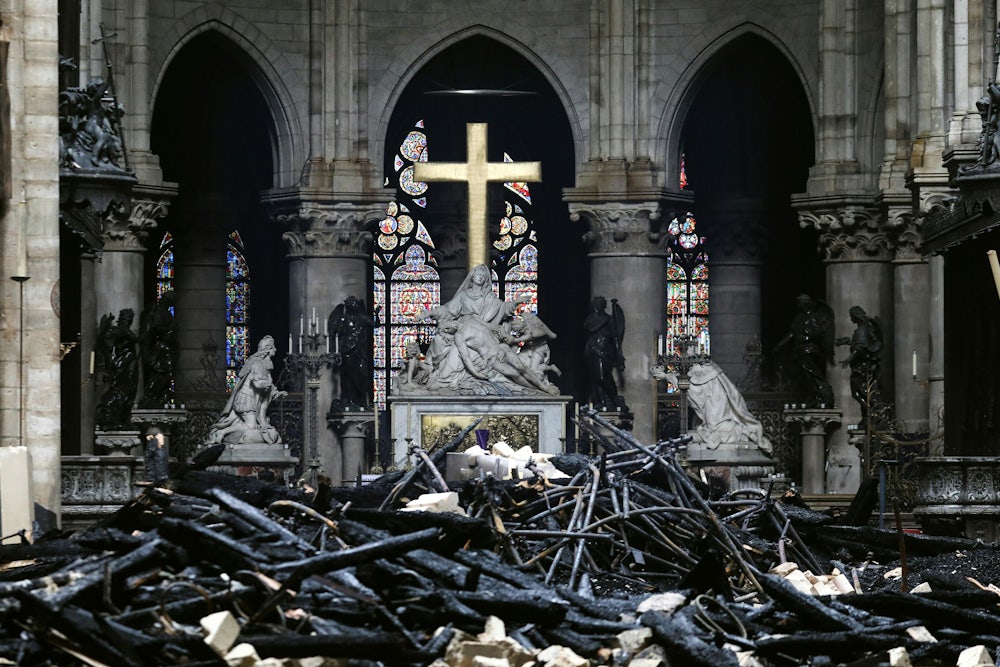Fire has held a certain mystical power in the human mind since Prometheus stole it from the gods. When it burns down the spire of Notre Dame—one of Christendom’s great churches, resting at the heart of the French nation—the emotional effect can be tremendous.
Parisians and the world watched in horror on Monday as flames devoured much of the ancient cathedral, though it spared its iconic twin bell towers and most of the external stone structure. The cause appears to be accidental, according to Paris officials. The cathedral’s upper levels were built in the twelfth and thirteenth century with a “forest” of ancient oak trees, which became the kindling for Monday’s conflagration. Scaffolding and construction equipment on the roof may have provided the spark to ignite it. This mundane hypothesis doesn’t detract from the shock of watching an eight-century-old cultural landmark go up in flames.
Into that psychic void rushed numerous observers and commentators who sought to find a more profound meaning from the blaze, notably by tying it to the social unrest and political discord in France today. It’s human to try to find sweeping answers to seemingly random events. In their search for deeper truths, however, these analysts may have missed a conclusion that is more superficial—yet more significant.
President Emmanuel Macron has spent the last few months struggling to address the Yellow Vest movement, which has led waves of protests and riots against his unpopular economic policies. He had planned to deliver an address to the French people on Monday night to outline his latest response to the turmoil, but as news of the fire broke, he canceled those plans and rushed to the scene, vowing to rebuild the ancient cathedral. The fire “seemed to underscore the challenges heaped before his administration, which has struggled to reconcile the formidable weight of France’s ideals and storied past with the necessity for change to meet the demands of the 21st century,” The New York Times reported in its main story on the blaze.
Michael Kimmelman, the Times’ architecture critic, also saw parallels between the mass sorrow over the cathedral’s fate and public outrage over Macron’s reforms. “Generations that had come to rely on this social safety net, as a matter of national pride and identity, see it going up in smoke,” he wrote. “On Monday, so was the cathedral, which for centuries has enshrined an evolving notion of Frenchness. The symbolism was hard to miss.”
Others perceived an even deeper malaise. In The Guardian, Gilles Gressani and Mathéo Malik argued that the “catastrophe of Notre Dame represents so perfectly the condition of contemporary Europeans: people condemned to live among wonders, taking them for granted, ignorant of the fact that they may disappear—then suddenly finding themselves in a situation they’d never envisioned.” National Review’s Rich Lowry wrote that the cathedral “stands for so many qualities that we now lack—patience and staying power, the cultivation of beauty, a deep religious faith, a cultural confidence and ambition that could create a timeless monument of our civilization.” The Moscow Times quoted Russian commentators who saw the fire as an allegory for European decline.
A great blaze can serve as a blank slate onto which people project their social and cultural anxieties. When Rome burned in 63 A.D., imperial officials responded by persecuting the early Christians for abandoning the city’s polytheistic faith. Londoners blamed the great fire that gutted most of the English capital in 1666 on the Dutch, with whom they were at war, as well as supposed Catholic agents sent by France and Spain to destroy the Protestant metropolis. For centuries, Chinese philosophers viewed natural disasters as a sign that the ruling dynasty may have lost its divine mandate to govern. Elizabeth II’s “annus horribilis,” 1992, was marked by a destructive fire at Windsor Castle (as well as the personal scandals of her children).
The queen’s experience may be the most relevant. If there’s a takeaway from Notre Dame’s partial destruction, it’s profoundly simple: This was the inevitable result of neglect. The French state owns most of the country’s cultural patrimony, including Notre Dame and other major cathedrals. Government officials allocated $2.28 million per year for its maintenance and upkeep, including a small boost in recent years to restore the central spire. This was barely enough to keep the cathedral open and presentable to tourists, let alone the wholesale restoration and modernization that it desperately needed.
In 2017, Time magazine published an in-depth exploration of Notre Dame’s crumbling stonework, which had made parts of the structure almost too dangerous for people to enter. It also captured the lack of energy among civil servants to address the cathedral’s problems. “France has thousands of monuments,” the magazine quoted an unnamed official at the French Ministry of Culture as saying, suggesting that the cathedral was not a high priority. “It will not fall down,” she told the magazine. In a way, she was right. It burned instead.
Every country has its treasured landmarks that are expensive to maintain and even more costly to modernize. Britain’s Palace of Westminster, which houses the country’s Parliament, is among the most urgent cases. A 2017 investigation by The Guardian found that the baroque former palace is a dangerous tangle of Victorian steam pipes and twentieth-century wiring, and that Parliament was sluggish to address the problem. After decades of delays, lawmakers have finally agreed to vacate the building in the mid-2020s for a multi-billion-dollar renovation program.
If Westminster burns down before then, it will be because the British government failed to save it in time—a victim of the country’s political ossification. And if there is a lesson to be taken from Notre Dame’s fate for everyone else, it isn’t about the trajectory of European civilization or the upheavals of the French nation. It’s that humanity’s cultural heritage won’t save itself.
